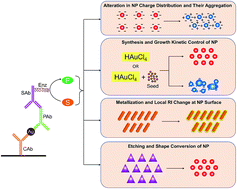Plasmonic-ELISA: expanding horizons
Abstract
The enzyme-linked immunosorbent assay (ELISA) has been an integral part of in vitro diagnostic tests due to its high specificity, standard configuration, and convenient readout. The convergence of the plasmonic property, i.e. localized surface plasmon resonance (LSPR), of noble metal nanoparticles with the ELISA technique has established a novel category of immunoassay, known as “plasmonic ELISA” (pELISA). It has enabled the naked eye detection of various disease biomarkers down to attomolar concentration. The color development relies on the biocatalytic reaction mediated modulation of LSPR properties. Through this review we present various current state-of-art pELISA strategies adopted for naked-eye quantification of disease biomarkers along with their advantages, limitations and applicability. These strategies are broadly classified into following four categories based on the different means of LSPR modulation: (i) aggregation, (ii) controlled growth kinetics, (iii) metallization, and (iv) etching of metal nanoparticles. Furthermore, the paper highlights the different biocatalytic reactions and their role in plasmonic color development as a function of analyte concentration. The review ends with an elucidation of current challenges and future perspectives of pELISA precisely focusing on the need for development of next generation low cost point-of-care diagnostic kits.


 Please wait while we load your content...
Please wait while we load your content...